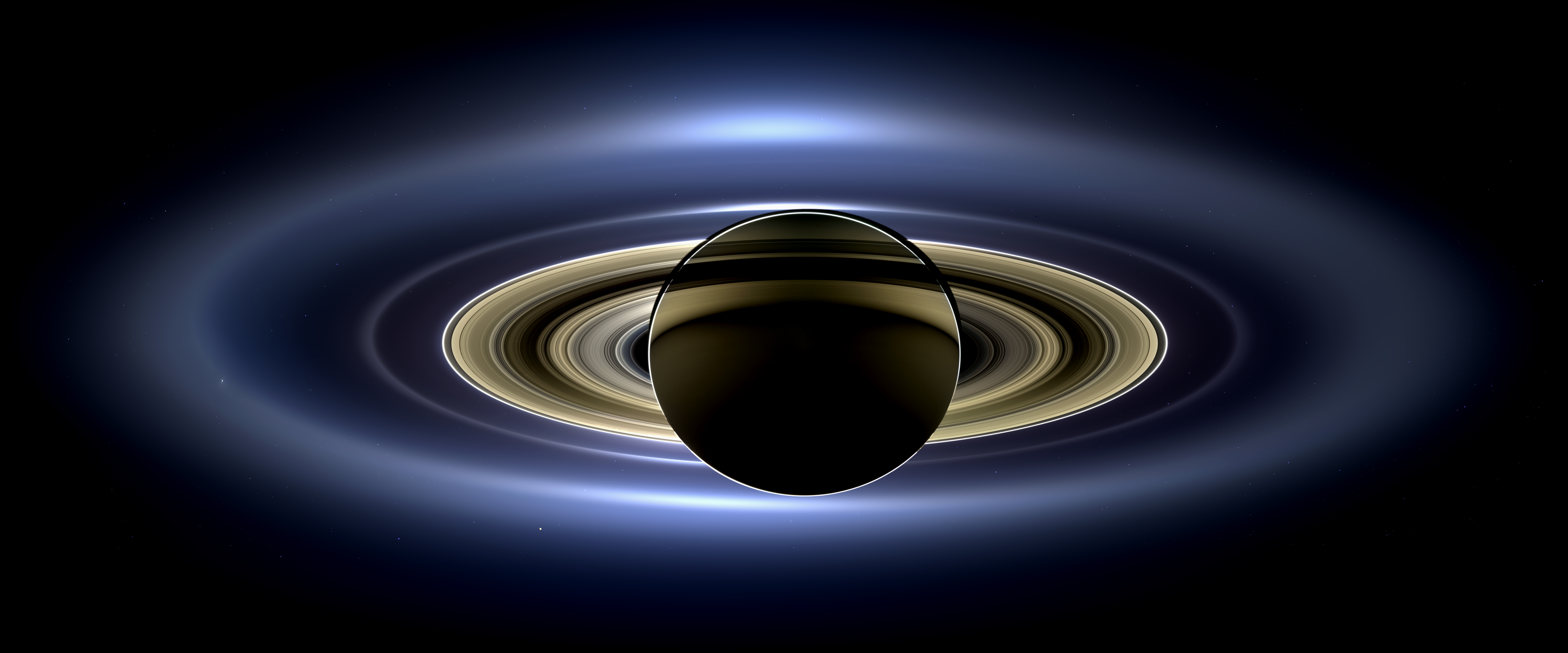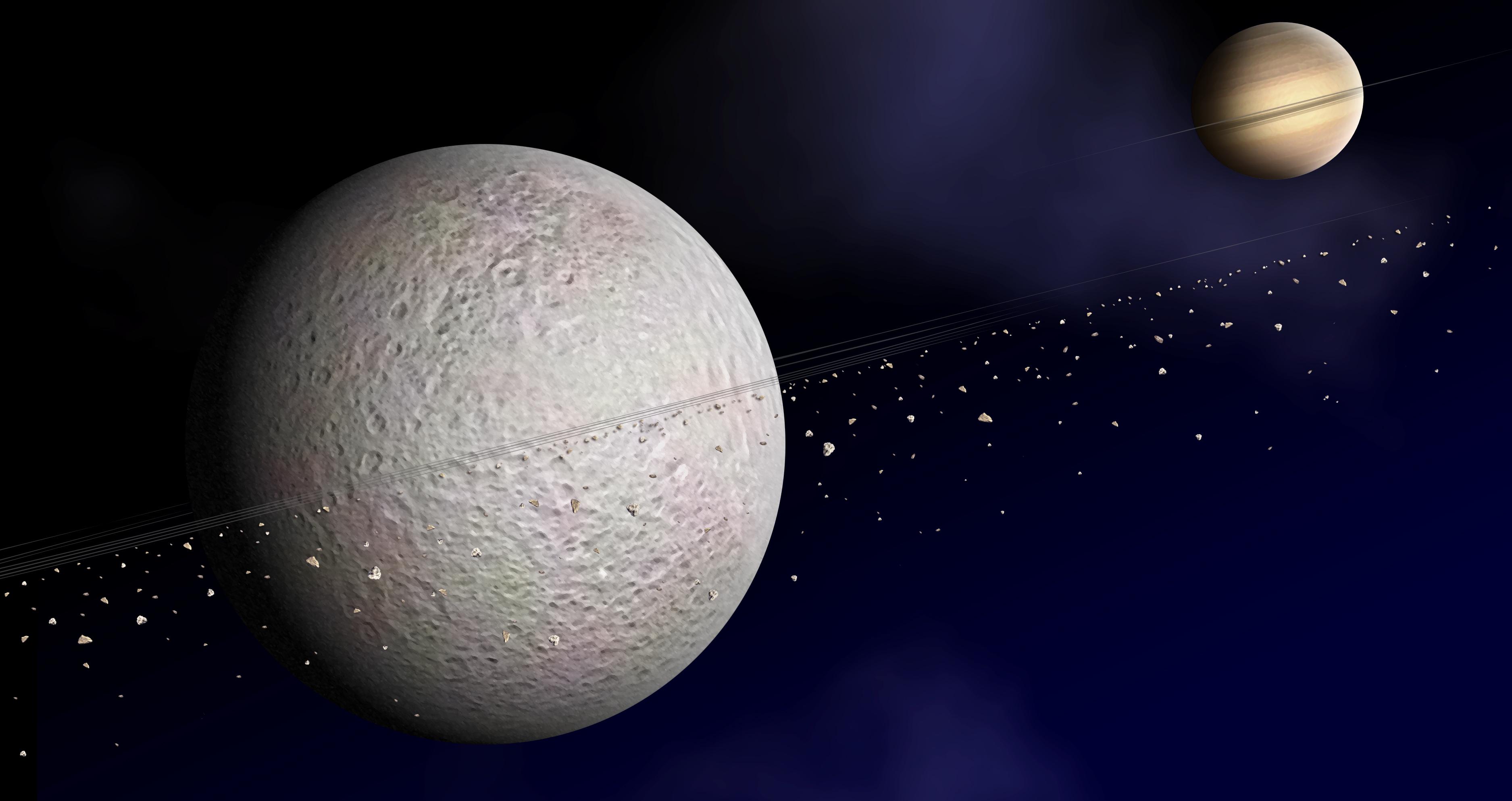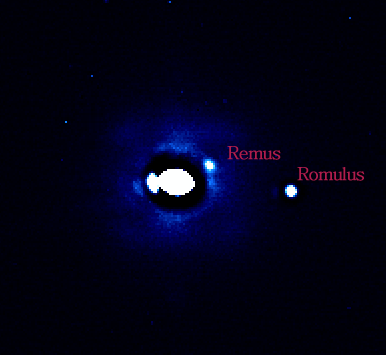|
Moonlet
A moonlet, minor moon, minor natural satellite, or minor satellite is a particularly small natural satellite orbiting a planet, dwarf planet, or other minor planet. Up until 1995, moonlets were only hypothetical components of Saturn's F-ring structure, but in that year, the Earth passed through Saturn's ring plane. The Hubble Space Telescope and the European Southern Observatory both captured objects orbiting close or near the F-ring. In 2004, Cassini–Huygens , Cassini caught an object 4–5 kilometers in diameter on the outer ring of the F-ring and then 5 hours later on the inner F-ring, showing that the object had orbited. Several different types of small moons have been called moonlets: * A belt of objects embedded in a planetary ring, especially around Saturn, such as those in the Rings of Saturn#A Ring, A Ring, S/2009 S 1 in the B Ring (Moons of Saturn#Ring moonlets, "propeller" moonlets), and those in the Rings of Saturn#F Ring, F Ring * Occasionally asteroid moons, ... [...More Info...] [...Related Items...] OR: [Wikipedia] [Google] [Baidu] |
S/2009 S 1
S/2009 S 1 is a Rings of Saturn#Propeller_moonlets, moonlet embedded in the outer part of Saturn's Rings of Saturn#B Ring, B Ring, orbiting away from the planet. The moonlet was discovered by the Cassini–Huygens, ''Cassini'' Imaging Team during the Saturnian equinox event on 26 July 2009, when the ''Cassini'' spacecraft imaged the moonlet casting a -long shadow onto the B Ring. With a diameter of , it is most likely a long-lived solid body, which would count it as the smallest and innermost known moon of Saturn. Discovery was first identified by the Cassini–Huygens, ''Cassini'' Imaging Team led by Carolyn Porco, in a single image taken by the ''Cassini'' spacecraft approximately from Saturn on 26 July 2009 11:30 UTC. The moonlet was discovered during Saturn's 2009 equinox, when it cast an approximately -long shadow on the planet's B ring. Characteristics Based on the shadow's width, the ''Cassini'' Imaging Team infer a diameter of for . The presence of a shadow sugge ... [...More Info...] [...Related Items...] OR: [Wikipedia] [Google] [Baidu] |
Bleriot (moon)
Bleriot (or Blériot), is the informal name for a propeller moonlet within Saturn's A Ring. It is about across, making it the largest of these propeller moonlets. It has been tracked by the ''Cassini'' Imaging Team since 2005. Bleriot has been subject to some scientific studies due to its large size and has helped scientists improve their understanding the interactions between objects within Saturn's rings. The orbit of Bleriot has some anomalies such as that it sometimes is much further behind or ahead than is predicted to be. The name comes from French aviator Louis Blériot, who was the first person to fly across the English Channel. Due to its small size, Bleriot cannot be directly imaged, it can only be noticed by the "propeller-shaped" disturbances it creates around it. See also * Peggy (moonlet) *S/2009 S 1 S/2009 S 1 is a Rings of Saturn#Propeller_moonlets, moonlet embedded in the outer part of Saturn's Rings of Saturn#B Ring, B Ring, orbiting away from the p ... [...More Info...] [...Related Items...] OR: [Wikipedia] [Google] [Baidu] |
Rings Of Saturn
Saturn has the most extensive and complex ring system of any planet in the Solar System. The rings consist of particles in orbit around the planet made almost entirely of water ice, with a trace component of Rock (geology), rocky material. Particles range from micrometers to meters in size. There is no consensus as to what mechanism facilitated their formation: while investigations using theoretical models suggested they formed early in the Solar System's existence, newer data from ''Cassini–Huygens, Cassini'' suggests a more recent date of formation. In September 2023, astronomers reported studies suggesting that the rings of Saturn may have resulted from the collision of two moons "a few hundred million years ago". Though light reflected from the rings increases Saturn's apparent brightness, they are not themselves visible from Earth with the naked eye. In 1610, the year after Galileo Galilei's first observations with a telescope, he became the first person to observe Saturn' ... [...More Info...] [...Related Items...] OR: [Wikipedia] [Google] [Baidu] |
Ring System
A ring system is a disc or torus orbiting an astronomical object that is composed of solid material such as dust, meteoroids, planetoids, moonlets, or stellar objects. Ring systems are best known as planetary rings, common components of satellite systems around giant planets such as the rings of Saturn, or circumplanetary disks. But they can also be galactic rings and circumstellar discs, belts of planetoids, such as the asteroid belt or Kuiper belt, or rings of interplanetary dust, such as around the Sun at distances of Mercury, Venus, and Earth, in mean motion resonance with these planets. Evidence suggests that ring systems may also be found around other types of astronomical objects, including moons and brown dwarfs. In the Solar System, all four giant planets (Jupiter, Saturn, Uranus, and Neptune) have ring systems. Ring systems around minor planets have also been discovered via occultations. Some studies even theorize that the Earth may have had a ring system du ... [...More Info...] [...Related Items...] OR: [Wikipedia] [Google] [Baidu] |
Natural Satellite
A natural satellite is, in the most common usage, an astronomical body that orbits a planet, dwarf planet, or small Solar System body (or sometimes another natural satellite). Natural satellites are colloquially referred to as moons, a derivation from the Moon of Earth. In the Solar System, there are six planetary satellite systems containing 418 known natural satellites altogether. Seven objects commonly considered dwarf planets by astronomers are also known to have natural satellites: , Pluto, Haumea, , Makemake, , and Eris. As of January 2022, there are 447 other minor planets known to have natural satellites. A planet usually has at least around 10,000 times the mass of any natural satellites that orbit it, with a correspondingly much larger diameter. The Earth–Moon system is a unique exception in the Solar System; at 3,474 kilometres (2,158 miles) across, the Moon is 0.273 times the diameter of Earth and about of its mass. The next largest ratios are the N ... [...More Info...] [...Related Items...] OR: [Wikipedia] [Google] [Baidu] |
Minor-planet Moon
A minor-planet moon is an astronomical object that orbits a minor planet as its natural satellite. , there are 457 minor planets known or suspected to have moons. Discoveries of minor-planet moons (and binary objects, in general) are important because the determination of their orbits provides estimates on the mass and density of the primary, allowing insights into their physical properties that are generally not otherwise accessible. Several of the moons are quite large compared to their primaries: 90 Antiope, Mors–Somnus and Sila–Nunam (95%), Patroclus–Menoetius, Altjira and Lempo–Hiisi (90%, with Lempo–Paha at 50%). The largest known minor-planet moon in ''absolute'' size is Pluto's largest moon Charon, which itself has about half the diameter of Pluto. There are also several known ring systems around distant objects (see: '' Rings of Chariklo'' and ''Chiron''). Terminology In addition to the terms ''satellite'' and ''moon'', the term "binary" (binary ... [...More Info...] [...Related Items...] OR: [Wikipedia] [Google] [Baidu] |
Subsatellite
A subsatellite, also known as a submoon or informally a moonmoon, is a "moon of a moon" or a hypothetical natural satellite that orbits the moon of a planet. It is inference, inferred from the empirical study of natural satellites in the Solar System that subsatellites may be rare, albeit possible, elements of planetary systems. In the Solar System, the giant planets have large collections of natural satellites. The majority of detected exoplanets are giant planets; at least one, Kepler-1625b, may have a very large exomoon, named Kepler-1625b I, which could theoretically host a subsatellite. Nonetheless, aside from human-launched satellites in temporary lunar orbit, no subsatellite is known in the Solar System or beyond. In most cases, the Tidal force, tidal effects of the planet would make such a system unstable on an astronomical timescale. Terminology Terms used in scientific literature for subsatellites include "submoons" and "moon-moons". Colloquial terms that have been sugg ... [...More Info...] [...Related Items...] OR: [Wikipedia] [Google] [Baidu] |
Amalthea (moon)
Amalthea () is a moons of Jupiter, moon of Jupiter. It has the third-closest orbit around Jupiter among known moons and was the fifth moon of Jupiter to be discovered, so it is also known as . It is also the fifth-largest moon of Jupiter, after the four Galilean moons. Edward Emerson Barnard discovered the moon on 9 September 1892 and named it after Amalthea (mythology), Amalthea of Greek mythology. It was the last natural satellite to be discovered by direct visual observation; all later moons were discovered by astronomical photography, photographic or digital imaging. Amalthea is in a close orbit around Jupiter and is within the outer edge of the Rings of Jupiter#Amalthea gossamer ring, Amalthea Gossamer Ring, which is formed from dust ejected from its surface. Jupiter would appear 46.5 degrees in diameter from its surface. Amalthea is the largest of the inner satellites of Jupiter and is irregularly shaped and reddish in color. It is thought to consist of porous water ... [...More Info...] [...Related Items...] OR: [Wikipedia] [Google] [Baidu] |
Jupiter
Jupiter is the fifth planet from the Sun and the List of Solar System objects by size, largest in the Solar System. It is a gas giant with a Jupiter mass, mass more than 2.5 times that of all the other planets in the Solar System combined and slightly less than one-thousandth the mass of the Sun. Its diameter is 11 times that of Earth and a tenth that of the Sun. Jupiter orbits the Sun at a distance of , with an orbital period of . It is the List of brightest natural objects in the sky, third-brightest natural object in the Earth's night sky, after the Moon and Venus, and has been observed since prehistoric times. Its name derives from that of Jupiter (god), Jupiter, the chief deity of ancient Roman religion. Jupiter was the first of the Sun's planets to form, and its inward migration during the primordial phase of the Solar System affected much of the formation history of the other planets. Jupiter's atmosphere consists of 76% hydrogen and 24% helium by mass, with a denser ... [...More Info...] [...Related Items...] OR: [Wikipedia] [Google] [Baidu] |
Amalthea Moonlets
Amalthea () is a moon of Jupiter. It has the third-closest orbit around Jupiter among known moons and was the fifth moon of Jupiter to be discovered, so it is also known as . It is also the fifth-largest moon of Jupiter, after the four Galilean moons. Edward Emerson Barnard discovered the moon on 9 September 1892 and named it after Amalthea of Greek mythology. It was the last natural satellite to be discovered by direct visual observation; all later moons were discovered by photographic or digital imaging. Amalthea is in a close orbit around Jupiter and is within the outer edge of the Amalthea Gossamer Ring, which is formed from dust ejected from its surface. Jupiter would appear 46.5 degrees in diameter from its surface. Amalthea is the largest of the inner satellites of Jupiter and is irregularly shaped and reddish in color. It is thought to consist of porous water ice with unknown amounts of other materials. Its surface features include large craters and ridges. Clo ... [...More Info...] [...Related Items...] OR: [Wikipedia] [Google] [Baidu] |
87 Sylvia
87 Sylvia is one of the largest asteroids (approximately tied for 7th place, to within measurement uncertainties). It is the parent body of the Sylvia family and member of Cybele group located beyond the main asteroid belt (see minor-planet groups). Sylvia was the first asteroid known to possess more than one moon. Discovery and naming Sylvia was discovered by N. R. Pogson on 16 May 1866, from Madras (Chennai), India.Pogson, N. R. (1866), Minor Planet (87) Sylvia', Monthly Notices of the Royal Astronomical Society, Vol. 26, p. 311 (June 1866) Antonio Paluzie-Borrell, writing in Paul Herget's ''The Names of the Minor Planets'' (1955), mistakenly states that the name honors Sylvie Petiaux-Hugo Flammarion, the first wife of astronomer Camille Flammarion. In fact, in the article announcing the discovery of the asteroid, Pogson explained that he selected the name in reference to Rhea Silvia, mother of Romulus and Remus (''MNRAS'', 1866). Physical characteristics Sylvia is ve ... [...More Info...] [...Related Items...] OR: [Wikipedia] [Google] [Baidu] |










